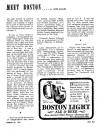
|
MEET BOSTON Friday, August 22, 1941 in What's New In Town W. J. Sidis |
In case anyone at present thinks that the streets of Boston are crooked, it might be in point to remind them of the old-time Avery Street, as many Bostonians still can remember it.
It was, as Avery Street is nowadays, a thoroughfare between Washington Street and Tremont Street, but that fact seemed to be a deep and dark secret to all except those who were very familiar with Boston of that day. It was a narrow passage, being, in spots, not over eight feet wide, and, as the street took no less than four right-angled bends in its short length, it looked like a blind alley from ether end; the discovery that it was a through way was practically a sign of initiation into the inmost mysteries of Boston. About 1915, a major operation was performed on this section of town. Every portion of Avery Street was widened―enough to eliminate two of the four bends, making that part of the street into an extension of Mason Street; the widened Tremont Street end of the old alley became the present branch of Mason Street leading to Tremont Street; while the line Avery Street followed from Washington Street was not only widened but continued by cutting through along the same line to Tremont Street, giving the present Avery Street, which anyone can see is a through street.
*
The first actual declaration of independence was issued by Suffolk County, Mass (now covering both Suffolk and Norfolk Counties), at a County Convention held in Milton on [Tuesday] September 6, 1774, when a resolution, then called the Suffolk Resolves, declared Suffolk County absolved from allegiance to the king.
Plymouth County followed with an endorsement of the Suffolk Resolves, in October 1774.
Later declarations of Independence that followed were: Mecklenburg County, N.C.; Rhode Island, May 4, 1776. In May of 1776, a referendum of Massachusetts town meetings voted for independence, and Connecticut and Virginia declared their independence. The Philadelphia declaration in July, 1776, was merely to make it unanimous. It was passed by Congress on [Tuesday] July 2, though it bore the official date of July 4. It was not agreed to by New York until July 18, after several New York delegates resigned from Congress. New York City and its vicinity remained a loyalist stronghold, and, except for a few months of rebel occupation, stayed in the Empire til November 25, 1783.
*
People who have been in Boston in past seasons, and have come back this summer, may be a bit confused by the apparent absence of any form of public transportation on Huntington Avenue. They will find the same old street cars underground―stations at Symphony Hall (Huntington and Massachusetts Avenues), at Mechanics Building, and at Copley Square (at Dartmouth and Boylston).